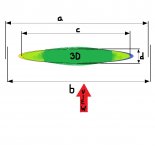looksharp65
Well-known member

I have tried to make another graphic illustration of the binoculars' 3D-area , based on the thoughts above. I cannot guarantee they conform to scientifical proofs, however. I make no claims that the drawing is according to scale or proportional.
It needs to be pointed out that the 3D-area is not actually a flat area within the visual field, but rather a virtual volume with loose boundaries.
a= Left barrel's FOV
b= Right barrel's FOV
c= Joint sweet spot of both barrels (a floating value, dependent from judgement of sharpness)
d= Depth of field - another floating value
Red arrow= Direction of view (drawing shows the FOV and DOF from above)
I make the assumption that not the entire joint sweet spot will provide maximum 3D clues, since a minor image separation will be diminished or hidden when the viewing angle is oblique.
Furthermore, I assume that the 3D-volume expands slightly behind and in front of the depth of field, since a major image separation will overrule a minor blur.
It needs to be pointed out that the 3D-area is not actually a flat area within the visual field, but rather a virtual volume with loose boundaries.
a= Left barrel's FOV
b= Right barrel's FOV
c= Joint sweet spot of both barrels (a floating value, dependent from judgement of sharpness)
d= Depth of field - another floating value
Red arrow= Direction of view (drawing shows the FOV and DOF from above)
I make the assumption that not the entire joint sweet spot will provide maximum 3D clues, since a minor image separation will be diminished or hidden when the viewing angle is oblique.
Furthermore, I assume that the 3D-volume expands slightly behind and in front of the depth of field, since a major image separation will overrule a minor blur.
Attachments
Last edited:





